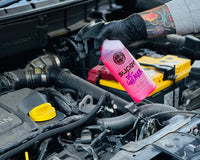A Paint Thickness Gauge (often abbreviated to PTG, and also called a Paint Depth Gauge) is an electronic device that measures the distance between the body-panel and the sensor. This way you can measure the thickness of the paint. This gives you an indication of how much paint you have left to work with.
How does it work
The paint thickness gauge has a sensor that sticks out of the bottom of the device, or is connected via a wire with the device. This sensor is than put on the surface of the panel you want to measure. You place it perpendicular to the surface. The device will then measure the distance between the body panel underneath the paint, en the sensor. That distance is the thickness of the paint. For example, if the total thickness of the paint is 0.2 cm (0.08 inch), the display will show 2000 µm (micrometre). Because this is the distance between the sensor and the body panel underneath the paint.
Different types
Paint thickness gauge that can measure independent layers There are a few different paint thickness gauges. The cheaper models can only measure the distance between the sensor and a metal panel. The more expensive models can measure the distance between the sensor and any body panel underneath the paint (even if it isn’t metal). The very expensive models can even measure the thickness of each layer independently. The cheaper models are used to just get a rough idea on what you are working with. The more expensive models can help you in the case of glass fiber or plastic body panels. The very expensive models can give you a very precise measurement of the thickness of each layer. This means you know exactly how much clear coat you have to work with.
Why the need for a paint thickness gauge
The polish has gone through the clear coat, and at places even through the colored coat. This is called a strike through When you are going to polish an area, it helps to know how much paint you have to play with. You remove paint by polishing, so every time a car gets polished, you remove a very fine layer of paint. Removing to much means you can either go through the clea coat (which can cause oxidation of the colored coat), or you can even go through the colored coat. Which means that you have a “strike through”, and the primer coat is showing. For example, you measure a thickness of 150 µm, and you know you remove 3 µm with every time you polish, you know you are a long way from reaching the bottom. In a theoretical world, you could say that the paint is made up out of a primer, a colored coat and a clear coat. 150 µm could then be divided into 3 layers of 50 µm. This would mean that you can polish the surface 16.5 times before going through the clear coat. And 33 times before going through the colored coat. However, it’s not that simple in real life. The thickness of each coat varies widely. 1 panel can have a primer coat of 30 µm, and the panel next to it can have a primer coat of 50 µm thick. The same goes for the colored coat and the clear coat. These all have very different thicknesses. This means that a paint thickness gauge can only give you an indication, and little insurance of safety.
Paint thickness
On average, most new complete paint thickness will be around 120 µm. However, this is just an average. If you would measure 10 brand new cars, and then calculate the average of each panel, you’ll end up with roughly 120 µm. On average the layers are reasonably equally divided in 3 layers of 40 µm thick. However, this is still just an average. It can not only differ greatly between 2 panels, it can even differ between 2 spots only a few cm apart from each other. If you are going to go through the trouble of making measurements, then it pays to do it right. This will offer you more information to rely on and will (in time) help you to get a better understanding of average paint thickness and how this can be important to the correction stage.
Read the original article at: https://www.detailingwiki.org/detailing-miscellaneous/paint-depth-gauge-pdg/?highlight=panel%20wipe














